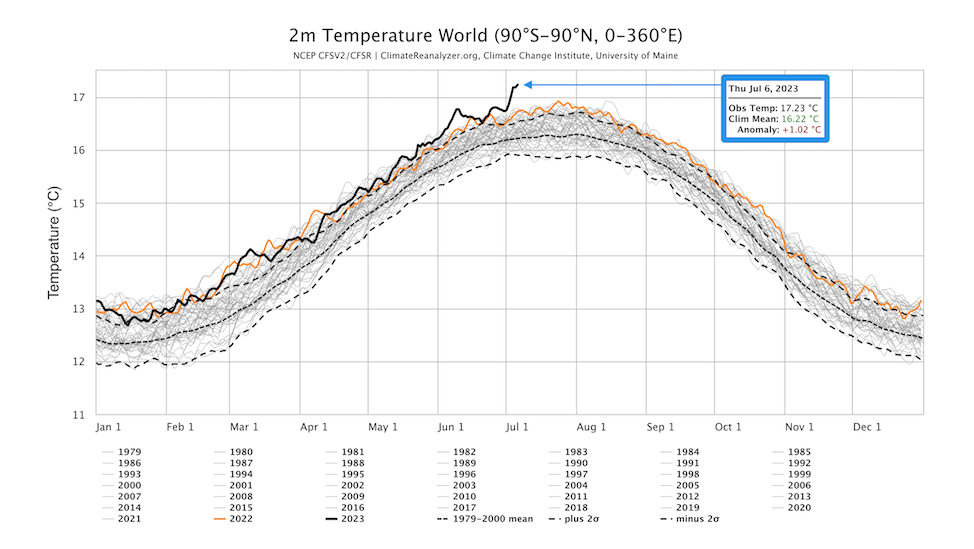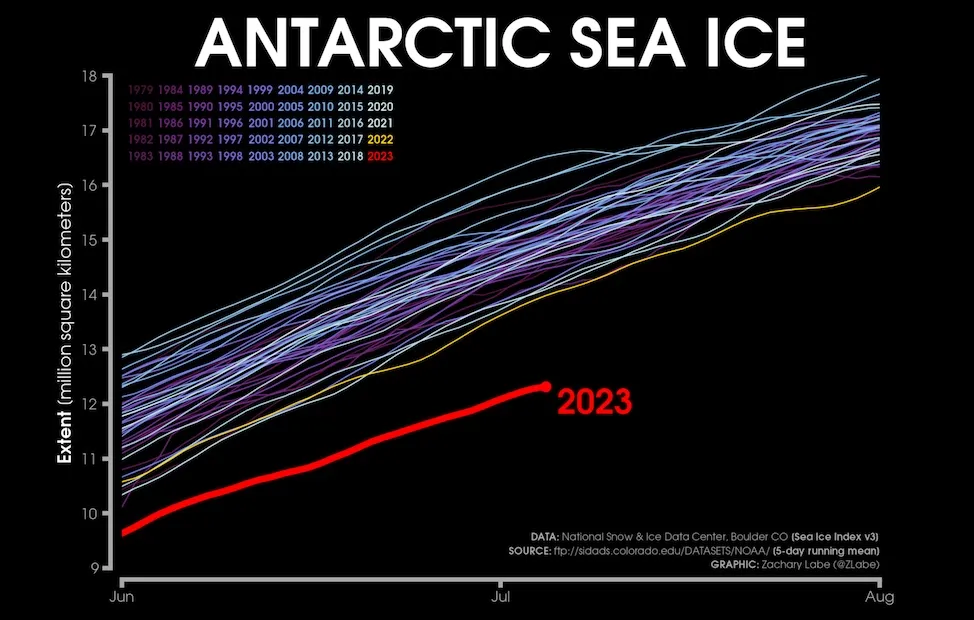Republished with permission from Yale Climate Connection, by
Mid-2023 seems destined to go down as a pivotal period in climate change history—a time when planet Earth seemed to go from a simmer to a full rolling boil in a matter of weeks. What’s jumping out isn’t a single heat wave, but a one-after-another series of global and regional heat records astounding in both scope and persistence.
The world just had the hottest June on record, with unprecedented sea surface temperatures and record-low Antarctic sea ice extent, according to a new report. #StateOfClimate
🔗 https://t.co/7ScabFvIG4 pic.twitter.com/SMOcXdnVUJ
— World Meteorological Organization (@WMO) July 6, 2023
Nothing’s changed in the fundamentals of climate change science. Tens of billions of tons of heat-trapping greenhouse emissions from fossil fuel burning are still being poured into the atmosphere each year. Those emissions are “only” increasing by a percent or so each year and they may well begin to drop later this decade as renewable energy continues to boom—but greenhouse gases from burning fossil fuels will continue to drive increased warming of the planet until net-zero emissions are achieved. The mammoth atmospheric burden of greenhouse gases we have added and continue to add will profoundly alter Earth’s climate for centuries, if not millennia, with myriad far-reaching and often-disastrous consequences.
What’s happened in recent weeks to turn the drip-drip-drip of climate warming into a full-on torrent? Below is a look at several of the most prominent global and regional records and some of the factors that may be leading to the recent spikes. We’ll have much more on local and regional heat records from June in our monthly climate roundup later in July. (And as you read on, keep in mind there’s an increasing number of strategies and solutions for emission reduction, as amply documented here at Yale Climate Connections and by such scientists as the incomparable Katharine Hayhoe.)
"Unsettling, uncomfortable, loaded with terrifying and localized data, but at the same time inspiring and full of hope – and delivered with passion and wit," … the best review of a talk I could ask for!
Watch here: https://t.co/nD7ontfS2z pic.twitter.com/AXn3t5Iks7
— The Real Prof. Katharine Hayhoe (@KHayhoe) June 30, 2023
Hottest single days globally on record. Drawing on multi-source analyses from NOAA of daily global temperature that extend back to 1979, the Climate Reanalyzer website shows that July 3, 2023, was the warmest single day on record—only to be toppled by July 4, tied on July 5, and broken again on July 6 (see Figure 1 below). The Copernicus Climate Change Project, part of the European Center for Medium-range Weather Forecasts, also pegged July 3 as a global record.
The record-smashing heat just keeps coming. July 3 was hottest day on record GLOBALLY, until July 4 was even hotter. Both based on UMaine's Climate Reanalyzer. Today forecast to be near or in record territory. With @MelinaWalling https://t.co/apC8P5Mcbw
— @borenbears (@borenbears) July 5, 2023

Figure 1. Daily surface air temperature, averaged across the entire globe by the NOAA Climate Forecast System and depicted by ClimateReanalyzer.org for each day since 1979. Compared to the daily record of 16.92°C (last reached on July 24, 2022) that stood until this July, the global average of 17.23°C on July 6, 2023, was 0.31°C higher—an enormous margin for such a globally averaged value. (Image credit: Climate Change Institute, University of Maine)
There’s no comparable data set going back before 1979, but given what we know about global temperature trends, it’s not out of the question these were the warmest globally averaged days in centuries, and perhaps even in the 100,000-plus years since the onset of the last ice age. More such daily records are possible over the next several weeks, as Earth’s surface air temperature usually peaks in July and early August.
Highest global monthly average for any June. The Copernicus project found that last month was the warmest June in its 45-year-long data set, and it wasn’t even close.
BREAKING: June 2023 has blown away all prior records for the month of June, coming in at a staggering 0.16C above the prior record set in 2019.
It was around 1.46C above the typical temperatures we saw in June in the preindustrial era (1850-1899). pic.twitter.com/7D5yR11n0z
— Zeke Hausfather (@hausfath) July 3, 2023
Similar monthly reports from NASA and NOAA are due to be released on Thursday, July 13, and we’ll cover those in the June climate roundup. Given the magnitude of the Copernicus anomaly, it would be no shock if NASA and NOAA also deem last month to be the warmest June on record. (It’s unlikely to be the warmest of any month on record, though, since July is typically even warmer globally.)
Warmest global sea surface temperatures on record, relative to average. Because there is more ocean in the Southern versus the Northern Hemisphere, global sea surface temperature doesn’t peak till March—but compared to averages for the date, global sea surface temperatures have reached new highs for the past few weeks, as shown in NOAA data analyzed by Leon Simon.
The month of June also set a record for any month in terms of departure from average global sea surface temperatures, as noted by Brian Brettschneider.
BREAKING: Not only were the June sea surface temperatures (SSTs) the warmest for any June on record, but the June departure from the 20th Century average was the largest for any month on record. 🔥 pic.twitter.com/s7qf1g0Cc8
— Brian Brettschneider (@Climatologist49) July 3, 2023
The warming has been especially dramatic across the North Atlantic, where the largest anomaly by far in 45 years of satellite-based data occurred on June 21. North Atlantic sea surface temperatures typically peak in August.
Just incredible… the average sea surface temperature in the North Atlantic during June was 22.70°C. Going back to 1854, no other year has even come close. This is 0.89°C above the 1991-2020 climatology, and 0.32°C above the previous record. pic.twitter.com/52r0hSd3ta
— Brian McNoldy (@BMcNoldy) July 4, 2023
Slowest-growing Antarctic sea ice on record. The ring of sea ice around Antarctica shrinks to a shadow of itself each southern summer, then quickly expands to become even larger than the Arctic’s peak extent by late southern winter. That rapid seasonal growth has been strangely slow in recent weeks. As of July 4, according to the National Snow and Ice Data Center, the Antarctic sea ice extent of 12.28 million square kilometers was more than 1.5 million square kilometers below the previous record low for the date—a gigantic anomaly, and a full month later than such a low extent typically persisted during the years 1981-2010.
Combining the Arctic and Antarctic sea ice extent is a bit of an apples-and-oranges project, since the ice in the two basins forms in starkly different modes and with a six-month offset—but for what it’s worth, global sea ice extent was just over 4.0 million square kilometers below average on July 6. That’s the lowest anomaly on record outside of Nov-Dec. 2016, according to Zachary Labe.

Figure 2. Antarctic sea ice extent (in millions of square kilometers) for every June-to-August period across the satellite era, which began in 1979. (Image credit: Zachary Labe)
A rogue’s gallery of culprits
First and foremost among the prime movers of the recent global heat is (no surprise) global warming. In a world being warmed by human actions, we expect to see heat records of all types and dimensions popping up over time.
What’s remarkable is the sheer variety and intensity of the anomalies in recent weeks, which is itself an unprecedented clustering. There’s actually an interrelationship among all these records because oceanic warmth is such a crucial driver of atmospheric warmth. Close to 90% of the energy trapped by added greenhouse gases is stored in the global ocean, so it only takes a minor shift in ocean storage to have huge consequences on the adjacent atmosphere. The global storehouse of oceanic heat measured to depths of 2,000 meters (6,600 feet) has hit record highs almost every year since 2000, and it did so again in 2022.
The oceans have stored an even larger-than-usual share of energy since 2020 because of the three-year La Niña period that ended in early 2023, the first such “triple-dip” La Niña event in more than 20 years. During La Niña, an outsized share of the energy trapped by greenhouse gases goes into the deeper ocean; meanwhile, the global atmosphere tends to run slightly cooler than it otherwise would, all else being equal. Now that Earth has quickly jumped from La Niña into El Niño conditions, additional heat is being transferred from the deep ocean to the ocean surface and the to atmosphere, especially across the eastern tropical Pacific where El Niño and La Niña effects are centered.
Since it’s now considered more likely than not that the current El Niño will reach the “strong” category, it’s useful to consider the last two strong El Niño events: 1997-98 and 2015-16. In both cases, the first year (1997 and 2015) set new global annual heat records that were quickly transcended in the second year (1998 and 2016).
Last month, the statistics-based NOAA Global Annual Temperature Rankings Outlook gave only a 13% chance of a new global record in 2023, a value that seems very likely to rise in July. Going by the El Niño history above, it seems plausible that global temperatures could approach or reach a new record in 2023 and surge past that in 2024. In fact, the global annual air temperature in 2024 may actually approach the 1.5°C-over-preindustrial threshold (widely accepted as shorthand for crossing into a newly dangerous climate state), and it could easily surge beyond 1.5°C on particular days, weeks, or even months during the next couple of years. However, the multiyear average, which is what most of the 1.5°C science hinges on, is unlikely to cross 1.5°C until later this decade or beyond, as reflected in the latest five-year outlook from the World Meteorological Organization.
Jet-stream weirdness—not well understood, but with some links to human-caused climate change—has been a key facet of Northern Hemisphere weather and climate in recent weeks. Intense high pressure developed over Canada in late spring, leading to record summerlike heat in May and June, parching the landscape, and laying the foundation for massive wildfires from Alberta to Quebec and recurrent smoke plumes flowing into the United States. As the main polar jet stream arced far to the north around the Canadian high, a subtropical branch kept June largely mild over much of the central and eastern U.S., with widespread and frequent hailstorms.
In contrast to much of the world, New York, Los Angeles, and Washington, D.C., all had unusually cool Junes. Meanwhile, the subtropical zone from northern Mexico to Texas and parts of the Gulf Coast suffered in record-melting heat, with extreme moisture pushing heat indices above 115°F in some areas.
Atmospheric circulation changes from climate change are a key reason why extreme weather has taken such a leap in recent years, but the science behind exactly what is happening is poorly understood. Current jet stream weirdness may be a good example. https://t.co/uWEj51otQI
— Jeff Masters (@DrJeffMasters) June 30, 2023
New paper by Preece et al. shows that the increase in high pressure over #Greenland in summer that has accelerated #IceSheet melt is favored by diminished North American #snowcover via a stationary Rossby wave. @TLMote @judah47 @DrKnoxUGA @GKooperman https://t.co/0YlnxCUY13 pic.twitter.com/ni4Qoy1S39
— Nature Communications (@NatureComms) June 30, 2023
Across the North Atlantic, a couple of other factors have been in play. The semi-permanent Azores High, which steers easterly winds across the tropical Atlantic, was notably weaker and further west than usual in June. The weaker winds reduced the amount of surface mixing with deeper, cooler water, allowing sea surface temperatures over much of the North Atlantic to vault to record warmth. The weaker Azores High also helped put a dent in Saharan Air Layer events, whereby dust-laden winds stream off Africa across the tropical and subtropical Atlantic, helping shade and cool the waters.
These maps give some perspective on the remarkable weakening and westward displacement of the Azores High this June resulting in reduced easterly trade winds and less ocean mixing (cooling) which helped slingshot the Atlantic to record warmth. pic.twitter.com/L9akgkH58O
— Michael Lowry (@MichaelRLowry) July 3, 2023
On top of this, there’s a multiyear warming effect going on because of a drastic reduction in sulfur dioxide aerosols belched out by shipping. New global rules were implemented by the International Maritime Organization in 2020, and these have reduced sun-blocking sulfur emissions from shipping by roughly 85%, bringing the global values to their lowest levels in more than half a century. The new rules are great news in the fight against regional air pollution and longer-term climate warming, but as many scientists have cautioned, reducing sulfate aerosols will also give you a bump-up in air temperature. The biggest regional influence is across the busy shipping lanes of the North Pacific and North Atlantic.
For decades this area has been kept relatively cool by sulfur emissions from ships.
But this changed in 2020. pic.twitter.com/DFD39uyVJ3
— Leon Simons (@LeonSimons8) March 8, 2023
A new analysis from Carbon Brief estimates that global temperature will rise by an additional 0.04°C between 2020 and 2040 because of the sulfate reductions. Most of that rise is projected to occur in the first five years (2020-2025), so we’re now squarely in that period. The added warmth is tiny compared to the expected increase in global temperature in the next 20 years, but one would expect a greater impact on sea surface temperatures in and around the peak shipping routes, including the North Atlantic. Robert Rohde of Berkeley Earth estimated that sea-surface-temperature warming in the northern shipping lanes may be enhanced by about 0.2°C by the sulfate cuts. He added: “Temperatures in the North Atlantic have been setting records for this time of year by > 0.5 °C … I suspect sulfur reductions are partly responsible, but other factors (e.g. El Niño, global warming, low Sahara dust) also likely play large roles.”
Clouds and water vapor may be part of the global story as well. Kevin Trenberth of the National Center for Atmospheric Research and the University of Auckland, a longtime climate expert and co-author of annual reports on oceanic heat, said in an email: “With the much higher sea surface temperatures, it means there is a lot more water vapor in the atmosphere.” Since water vapor is itself a powerful greenhouse gas, “it amplifies the warming a lot.” Moreover, an index of Earth’s energy imbalance from the NASA program CERES has been running at record highs in recent months, according to Trenberth, and it appears a drop in global cloud cover could be a major factor.
Trenberth stressed that—as with so much about the global heat spikes of recent weeks—“questions remain.”
Yet another wild-card element related to water vapor was a colossal undersea volcanic eruption in Tonga on Jan. 12, 2022. The Hunga Tonga–Hunga Ha’apai volcano sent roughly 146 megatons of water vapor into the stratosphere, increasing the water content at that altitude by as much as 15%. The sun-blocking sulfur dioxide aerosols from a major land-based volcanic eruption can cool global climate for a year or two, as was the case with Mount Pinatubo in the early 1990s. However, the underwater eruption of Hunga Tonga–Hunga Ha’apai injected more than 200 times more water vapor than sulfate aerosol into the stratosphere, shifting the scales toward a warming effect. As a result, global temperature could be nudged upward by several hundredths of a degree Celsius for the next several years, a study in Nature Climate Change estimated—perhaps enough to raise the odds by a few percent of temporarily breaching the 1.5°C threshold.

Yale Climate Connections
Yale Climate Connections is a nonpartisan, multimedia service providing daily broadcast radio programming and original web-based reporting, commentary, and analysis on the issue of climate change, one of the greatest challenges and stories confronting modern society.
Since the fall of 2007, Yale Climate Connections has aimed to help citizens and institutions understand how the changing climate is already affecting our lives. It seeks to help individuals, corporations, media, non-governmental organizations, government agencies, academics, artists, and more learn from each other about constructive “solutions” so many are undertaking to reduce climate-related risks and wasteful energy practices.
